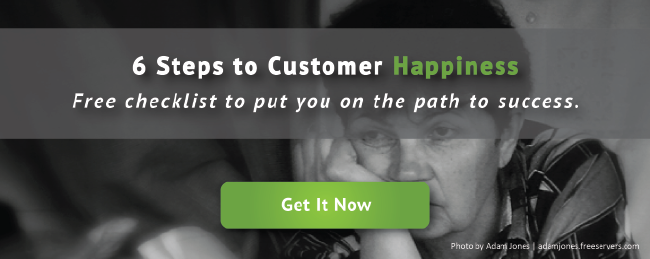You have been working hard to get your CEO to buy into the need to get closer to customers. You’ve gotten here through social feedback, anecdotes, and gut feel. But now, leadership understands a formal Voice of the Customer program is essential to achieving your customer experience goals.
You have the green light to start to ask customers for feedback!
But wait. Now what?

You can't listen to customers if you don't know how to reach them. And you can't make sense of the feedback if you don't know who they are. So how do figure out who you want to hear from and how to reach them?
Here’s the simple truth: the quality and depth of your future insights depends upon the quality and depth of the information you start with. But you can start with very little and add more as necessary. So, without further ado:
Basic Customer Data: Starter Information
If you don’t have a framework for collecting customer data, then you might want to start by grabbing the low-hanging fruit. Go for the five W’s and one H.
-
Customer Name and Contact Information: Once you decide how you’re collecting feedback—whether via email, SMS, or even phone interviewing or mail survey (in which case you’re in the 1980s)—you need to answer two basic questions: who are the customers, and where do you reach them? Your customer information file needs to include, at the very least: First Name, Last Name, Email Address, or Mobile/Phone Number or Mailing Address.
-
Categories and Triggers: Your customer information file also should include information to categorize each customer according to triggers you define. For example, are you sending an invitation for feedback based on a recent event or interaction? Or is it something more? For example, we’ll conduct Wows and Woes studies to dive into a client’s Net Promoter Score (NPS) or Customer Satisfaction. That leads to learning why customers choose to promote brands, and what is interfering with positive experiences? Here are some other examples of triggered data collection:
-
One of our clients—a wireless provider—invites feedback from customers after meaningful interactions, such as visits to a retail store or calls into the contact center. This helps them decide what they’ll do to improve their touch points.
-
Many of our B2B clients trigger invitations at the end of an engagement, or during critical milestones if the engagement is ongoing. This allows them to determine sentiment both when clients conclude relationships and when they continue.
-
Still others send feedback less regularly to a large, representative group or sample of customers in order to gain a baseline.
Whichever camp you fall into, you need to determine why you’re asking for feedback, and which touch points or moments of truth are most meaningful. That will help you ensure that you, or your IT colleagues, are building your customer information file based on your needs.

Value-Add Information
While not essential, additional information about customers can be extremely valuable when analyzing feedback in aggregate. Here are some examples of information that can help you determine trends:
-
Demographic or “Firmographic” Information: For example, you may want to understand how customer feedback varies by country or region, gender, or age. In the B2B space, comparing feedback by sector, company size, or job level (e.g., decision maker, influencer, or day-to-day contact) can give more meaningful insights to drive relevant and effective action.
-
Relationship and Behavioral Information: Beyond identifying information, you may want to find out more about how customers interact with your company’s products and services. For example, you might ask about:
-
Tenure: How long has the person been a customer or client of the organization?
-
Product/Service Penetration: How many of your company’s products or services does this person use?
-
Lifetime Value: What is the long-term value of the customer or client?
-
Interaction Tendencies: How often does the customer interact with you?
-
Internal Relationships or Channel Preferences: Where or with whom do these interactions primarily take place?
The cool part about value-add information is that it’s helpful, but you don’t need it to get started. Also, if you decide it’s needed for the success of your listening program, at a later push, you can ask the customer to provide it.

Customer Feedback Survey Behavior Information
As you mature with your Voice of the Customer program, you may decide to correlate behavioral information with survey feedback data. Many of our Voice of the Customer clients, some of whom have been on this journey for some time, begin to ask questions about how prior survey responses (or the lack thereof) relate to future behavior. For example:
-
We helped one of our diversified-communications clients in the B2C space discover that a customer's level of engagement at one date correlated strongly with their likelihood of being a customer at a later date—and their adoption of additional services.
-
Another B2B client learned that as engagement increases over time, clients spend more. Also, static or declining engagement related to a decrease in value of the account to the business.
-
In trying to improve their prospect experience, one of our Voice of the Prospect clients learned that prospects who didn't give feedback after meaningful interactions with sales representatives were significantly less likely to buy from the company compared to those who did take the survey. (They also determined that even non-responses gave insight into interest.)
Just Get Started
When you decide to collect customer data, make sure you have approval and support from the senior leadership team. This is the most important thing at the onset. Next, to get going, start with the basics and collect additional data points as you go.
And remember: don’t panic. If your customer records need work, consider a partner to help you. After all, a good partner can help you determine your construct, aim you to your goals, and help you append more-detailed data to your survey feedback data at a later time.
Good luck!
–Kate Feather





%20(1).png)